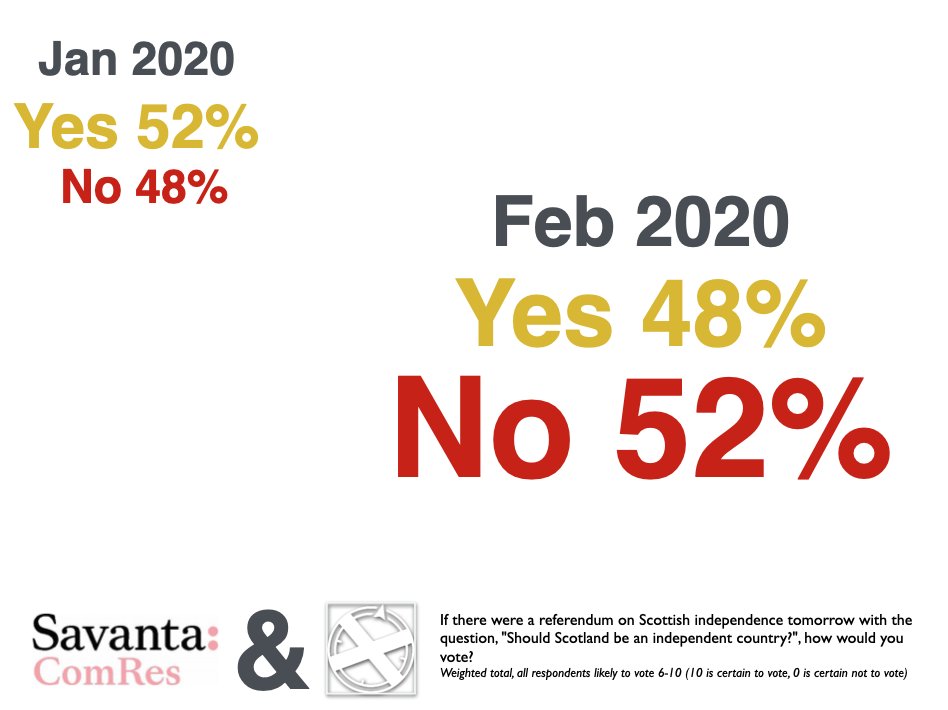
The latest poll from @ProgressScot actually now shows a majority back the union again. This has been missed because it's been buried in the data tables and using a radical weighting technique to benefit the yes side.
This thread explains what's going on.
This thread explains what's going on.

Changes to polling weighting have been vexing me for a while, and I couldn't quite put my finger on what was going on.
The latest data set from ComRes and Progress Scotland gave it away.
comresglobal.com/polls/scottish…
The latest data set from ComRes and Progress Scotland gave it away.
comresglobal.com/polls/scottish…
Previously polls were weighted by those intending to vote, you would do this by effectively excluding those below 6 on a scale of 1 to 10 where 10 is certain to vote.
But ComRes and @ProgressScot have changed that, no doubt influenced by the expertise of @markdiffley1
But ComRes and @ProgressScot have changed that, no doubt influenced by the expertise of @markdiffley1
When you look at these more traditional (and crucially comparable with the past, results. You get the following and a switch to No in February.
So why are the media going with results which show Yes still in the lead... well it's quite clever.
So why are the media going with results which show Yes still in the lead... well it's quite clever.

Instead of just counting those by intention to vote, all votes are now weighted by the likelihood to vote. So someone saying a 10 (certain to vote) compared to a 6 (likely but not certain) has a greater impact on the results.
So what you might say...
So what you might say...
Well two points, that's not the way it's been counted in the past so you are comparing apples and oranges.
Secondly it effectively rewards enthusiasm in the polling results. So very enthusiastic Yes voters have their say counted more than No voters...
Secondly it effectively rewards enthusiasm in the polling results. So very enthusiastic Yes voters have their say counted more than No voters...
It's these enthusiastic 'Yes weighted' votes that @ProgressScot release to the media first and then quietly drop in the traditional results buried deep in their results.
You might argue that's a perfectly legitimate way of doing polling. That's your right but at least understand what you are showing and what you are comparing.
This technique certainly projects the enthusiasm of a minority as a majority. Something the Yes side did in #indyref
This technique certainly projects the enthusiasm of a minority as a majority. Something the Yes side did in #indyref
You might also argue that No voters are not as enthusiastic so their opinion shouldn't count as much. But that's not the way to look at this. No voters don't want an #indyref so they are far less likely to be enthusiastic, weighting them down as a result is just plain wrong.
Does this mean we should dismiss the polling and the enthusiasm weighted technique? No absolutely not.
But it does mean the next time you see a poll of this nature you need to ask what we are seeing.
The results are clear for all to see in the underlying tables.
But it does mean the next time you see a poll of this nature you need to ask what we are seeing.
The results are clear for all to see in the underlying tables.
In Feb 2021 the No side became the majority again. That's significant and should be a huge media story, but @AngusRobertson deftly manipulated the media to publish his enthusiasm weighted figures.
It looks all to play for when it comes to the union. #Gameon
It looks all to play for when it comes to the union. #Gameon

Finally sorry I forgot the year in the graphic, it's been difficult enough in lockdown! Yes it should be 2021 and I've corrected it at the end!
Addendum: Turns out it was the Scotsman and not @ProgressScot or @AngusRobertson who commissioned this poll. They have my sincere apologies.
That doesn't detract from the data but does explain why certain journalists were edgy about this challenge.
That doesn't detract from the data but does explain why certain journalists were edgy about this challenge.
• • •
Missing some Tweet in this thread? You can try to
force a refresh


